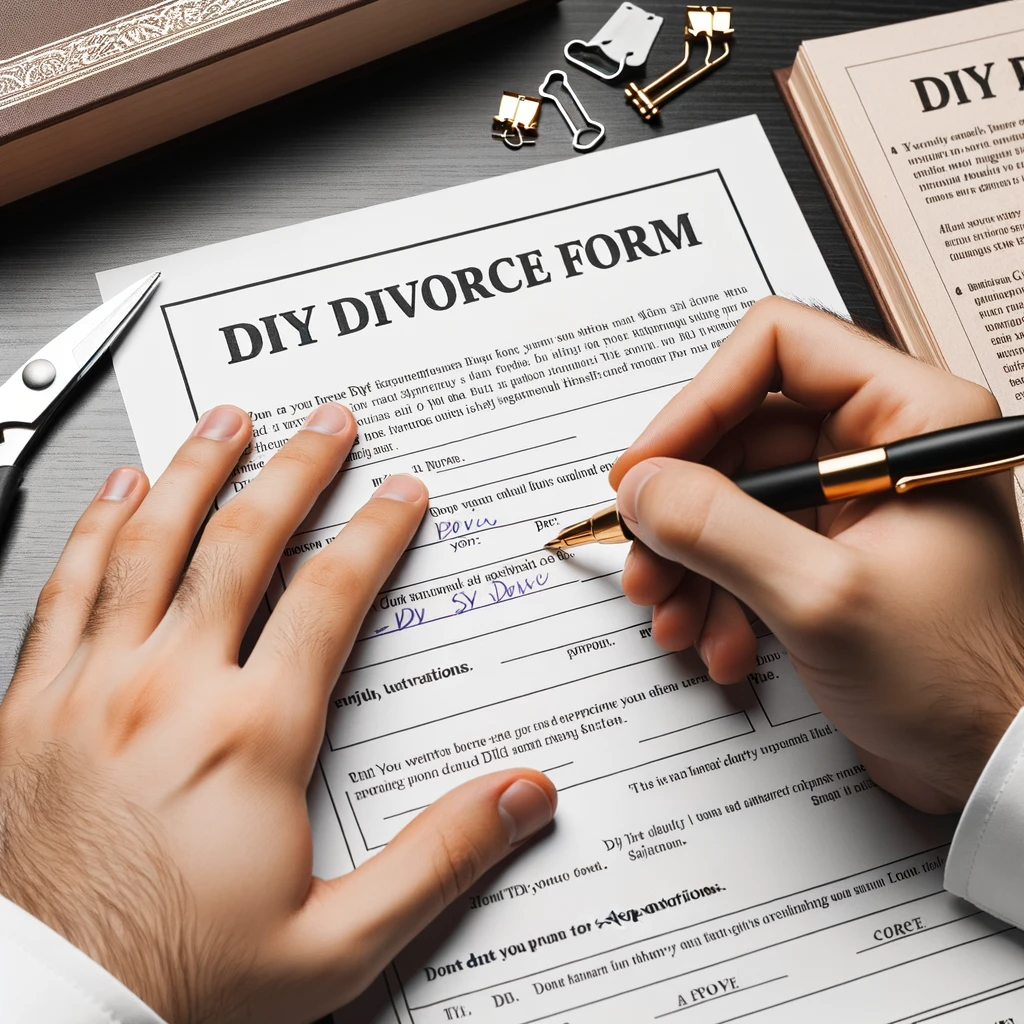Ending a marriage can be a daunting and emotionally charged process. While many couples elect to use a lawyer to navigate the divorce process, some choose to initiate a “do-it-yourself” (DIY) divorce, handling the matter themselves without legal representation.
In this section, we will explore the concept of DIY divorce, discussing whether it is a viable option for couples looking to end their marriage. We will provide a brief overview of how the DIY divorce process works and highlight its key advantages and disadvantages. Additionally, we will explain the difference between DIY divorce and separation, to provide clarity on both legal procedures.

- Understanding the DIY Divorce Process
- Gathering Essential Documents and Information
- Completing and Filing Divorce Forms
- Navigating Legal Requirements and Timelines
- Understanding Asset Division and Alimony
- Child Custody and Support Considerations
- Common Pitfalls to Avoid in a DIY Divorce
- Benefits and Drawbacks of DIY Divorce
- Conclusion




Key Takeaways
- DIY divorce is a potential option for couples looking to end their marriage without legal representation.
- The DIY divorce process can be a cost-effective alternative to hiring a lawyer, but it is not for everyone.
- Separation is different from a divorce and has its own legal procedures.
Understanding the DIY Divorce Process


DIY divorce is an option for couples looking to end their marriage without the assistance of a legal professional. However, it is important to understand the process and requirements before proceeding with a DIY divorce. Here, we outline the necessary steps to ensure a smooth and successful DIY divorce process.
Step 1: Obtain Divorce Forms
The first step in the DIY divorce process is to obtain the necessary divorce forms. These forms can typically be found on state court websites or at local courthouses. It is essential to ensure that the correct forms are obtained and filled out completely and accurately. Failure to do so may result in delays or a rejected filing.
Step 2: Understand Legal Requirements
Each state has specific legal requirements for divorce, including residency and waiting periods. It is essential to understand and meet these requirements before filing for divorce. Failing to meet these requirements may result in a dismissal of the case.
Step 3: Fill Out Divorce Forms
Once the necessary forms are obtained, they must be filled out completely and accurately. Some forms may require specific details, such as information about child custody or property division. It is essential to review the forms carefully and seek legal advice if necessary.
Step 4: File Divorce Forms
After the forms are filled out, they must be filed with the appropriate court and filing fees paid. It is important to follow the court’s procedures when filing, including any specific instructions for submitting the forms.
Step 5: Serve Divorce Forms
After filing the forms, they must be served to the other party according to the state’s legal requirements. This process ensures that the other party is aware of the divorce filing and has an opportunity to respond.
Step 6: Attend Court Hearings
Depending on the state’s requirements, one or more court hearings may be necessary to complete the divorce process. It is important to understand the court’s procedures and requirements for attending these hearings.
Overall, the DIY divorce process involves obtaining and filling out necessary forms, understanding legal requirements, filing the forms, serving them to the other party, and attending court hearings if necessary. It is important to approach the process with caution and seek legal advice when necessary to ensure a smooth and successful divorce process.
Gathering Essential Documents and Information


Before beginning the DIY divorce process, it is crucial to gather all necessary divorce documents and relevant financial and personal information. The documents required will vary depending on state laws and individual circumstances.
The essential divorce documents may include:
In addition to financial documents, it is imperative to have child custody arrangements in writing. The parenting plan should include details of custody and visitation schedules, holiday schedules, extra-curricular activities, and any other relevant information. The child custody arrangement should be reviewed by a legal professional to ensure it complies with local laws.
Gathering accurate financial and personal information is critical to ensure that all assets and debts are accounted for and divided equitably. A comprehensive checklist can be helpful to ensure no important documents or information is overlooked.
Completing and Filing Divorce Forms
Completing and filing divorce forms is a crucial step in the DIY divorce process. It is essential to understand the necessary details to be included in the forms and avoid common mistakes that may lead to legal consequences.
Filling out divorce forms:
The divorce forms may vary depending on the state you live in and the specific circumstances of your marriage. It is important to thoroughly research and understand the required forms and their contents. Most states provide the forms online, and in some cases, they can be filled out and submitted electronically.


It is crucial to take the time to fill out the forms accurately and completely. Failure to do so may lead to delays in the divorce process or even rejection of the forms by the court.
Court procedures and submission process:
Once the forms are completed, they must be submitted to the appropriate court. The submission process may also vary by state, so it is important to research and understand the specific requirements of your jurisdiction.
After the forms are submitted, the court will review the documents and may request additional information if necessary. It is important to follow up with the court regularly and provide any requested information promptly.
Hiring a professional:
While completing and filing divorce forms can be done without professional assistance, it may be beneficial to hire a lawyer or legal document preparer to ensure that everything is completed accurately and efficiently. Professionals can also provide guidance on court procedures and submission processes.
Overall, completing and filing divorce forms is a critical step in the DIY divorce process. It is important to understand the necessary details, avoid common mistakes, and seek professional assistance when necessary to ensure a smooth and successful divorce filing.
Navigating Legal Requirements and Timelines
When pursuing a DIY divorce, it is crucial to understand the legal requirements and timelines involved. Failure to meet these requirements can result in delays or even the dismissal of your case.
One important consideration is the residency requirement. In most states, you must have lived in the state for a certain period before filing for divorce. It is important to research and understand the specific requirements in your state before beginning the divorce process.
Another factor to keep in mind is the waiting period. Most states require a waiting period of several months after the divorce filing before the divorce can be finalized. It is important to note that this waiting period can vary depending on the specific circumstances of the case, so it is crucial to research and adhere to the legal timelines in your state.
It is also important to make sure you have filled out all necessary divorce forms correctly and completely. Any errors or omissions can result in rejection or delay of your case.
Overall, while a DIY divorce can save time and money, it is important to thoroughly research and understand the legal requirements and timelines involved to ensure a smooth and successful process.
Understanding Asset Division and Alimony
Asset division and spousal support are two of the most complicated aspects of a divorce, and a DIY divorce is no exception. Couples who choose this route must navigate these financial matters on their own, without the guidance of a lawyer.


Asset division requires the equitable distribution of marital property between the two parties. This can include real estate, investments, vehicles, and personal items. Before dividing assets, couples must first determine what is and is not considered marital property. A property settlement agreement can help make this process more straightforward and clear.
Spousal support, also known as alimony, may be necessary if one party has a higher income or earning capacity than the other. This applies when support is deemed fair and reasonable and may be awarded indefinitely or for a limited period. Creating a financial statement and analyzing the standard of living established during marriage can help determine the need for spousal support.




IMPORTANT NOTE:
It’s important to note that understanding asset division and spousal support is complex, and consulting with a legal professional is often advised.
Child Custody and Support Considerations
Child custody and support arrangements are among the most sensitive topics in a DIY divorce. It is crucial to prioritize the well-being of the children involved and create a parenting plan that works for both parties.
When determining child custody, it is essential to consider the best interests of the child, such as their education, health, and emotional needs. It may be helpful to consult with a mediator or child custody evaluator to reach an agreement that is fair and equitable for both parties.
In terms of child support, it is necessary to understand the legal requirements and calculations for determining support obligations. A parenting plan should outline the child support arrangements and any additional agreements, such as medical expenses or extracurricular activities.
It is important to note that courts can modify child custody and support agreements if there is a significant change in circumstances. Therefore, it may be beneficial to consult with a legal professional to ensure that the parenting plan is legally binding and will hold up in court.
Common Pitfalls to Avoid in a DIY Divorce
While a DIY divorce can be a cost-effective and straightforward way to end a marriage, there are several common pitfalls that individuals should be aware of. By avoiding these mistakes, you can ensure a smoother and more successful divorce process.
Inadequate Legal Research
One of the most significant pitfalls of a DIY divorce is inadequate legal research. It is essential to understand the specific legal requirements and timelines that must be met to avoid potential setbacks or even legal consequences. Failing to research thoroughly could lead to improper documentation or even court rejection of your case.
Improper Documentation
Another common mistake is improper documentation. It is crucial to provide accurate and complete information when filling out divorce forms and gathering essential documents. By double-checking all details, you can avoid causing unnecessary delays and complications.
Ignoring Legal Consequences
One of the most severe pitfalls of a DIY divorce is ignoring potential legal consequences. Divorce proceedings can have long-lasting and significant impacts, particularly when dealing with child custody or substantial financial matters. Seeking the advice of a legal professional can help avoid such legal issues.
Unrealistic Expectations
It is essential to set realistic expectations when embarking on a DIY divorce. While a DIY divorce can be a cost-effective way to end a marriage, it can also be time-consuming and challenging. Understanding the potential challenges and limitations can help prevent disappointment and ensure a smoother process.
Improperly Addressing Financial Matters
Finally, a significant pitfall of a DIY divorce can be the improper addressing of financial matters. Equitably distributing assets and addressing the potential need for spousal support can be complex and require legal knowledge. Seeking professional advice when dealing with significant financial matters is highly recommended.
Benefits and Drawbacks of DIY Divorce
Like any legal process, a DIY divorce has its pros and cons. It is important to consider them carefully before deciding whether to pursue this route.


Pros of DIY Divorce
- Cost-effective: One of the primary advantages of a DIY divorce is cost savings. Without the need for legal representation, couples may save thousands of dollars in legal fees.
- Control: With a DIY divorce, couples maintain complete control over the process. This can lead to a more amicable and less contentious split.
- Time-saving: Without the need to schedule consultations and court appearances with an attorney, couples may expedite the divorce process and reach a resolution more quickly.
Cons of DIY Divorce
- Legal complexities: The legal requirements for divorce can vary by state and are often complex. Without the guidance of a legal professional, individuals may risk making errors that could adversely affect the outcome of their divorce.
- Emotional toll: Divorce is an emotionally charged process. Without the support of an attorney, couples may struggle to navigate the emotional complexities of the divorce process.
- Incomplete settlement: It is not uncommon for couples to overlook important details in a DIY divorce settlement. This can lead to legal complications down the line, such as disputes over property or child custody arrangements.
Ultimately, the decision to pursue a DIY divorce should be made with careful consideration of these pros and cons. While a DIY divorce can be cost-effective and time-saving, it is important to recognize the potential risks associated with navigating the legal complexities of divorce without professional assistance.
Conclusion
In conclusion, a DIY divorce can be a viable option for some couples looking to end their marriage. It is a cost-effective solution that allows individuals to maintain control over the divorce process. However, it is important to understand the potential drawbacks and challenges of pursuing a DIY divorce.
Our recommendation is that couples carefully consider their personal situation and the complexity of their divorce before making a decision. For those with straightforward divorce cases and limited assets, a DIY divorce may be a suitable option. However, for those with more complex cases, involving substantial assets or child custody issues, it is recommended to seek professional legal assistance.




REMEMBER:
A DIY divorce requires a significant amount of time and effort, as well as careful attention to detail and legal requirements. While it may seem like a quick and easy solution, mistakes can lead to severe legal consequences.
Final Thoughts
Ultimately, the decision to pursue a DIY divorce should be made with careful consideration and awareness of the potential benefits and drawbacks. It is essential to prioritize the well-being of all parties involved, including any children affected by the divorce.
Whether you choose to pursue a DIY divorce or seek professional legal assistance, it is crucial to approach the process with patience, empathy, and a willingness to compromise.



FAQ
Is a DIY divorce possible?
Yes, it is possible to pursue a DIY divorce, also known as a do-it-yourself divorce. It involves handling the divorce process without hiring a lawyer.
How does a DIY divorce work?
In a DIY divorce, couples are responsible for completing and filing the necessary divorce forms themselves. They navigate the legal process independently, without the assistance of a lawyer.
What are the advantages of a DIY divorce?
Some advantages of a DIY divorce include cost savings, maintaining control over the process, and potentially faster resolution of the divorce.
What are the disadvantages of a DIY divorce?
Disadvantages of a DIY divorce may include the complexities of legal requirements, the potential for mistakes in completing forms, and the lack of professional legal advice.
What documents and information do I need for a DIY divorce?
Essential documents for a DIY divorce may include financial records, property ownership documents, and information about child custody arrangements.
How do I complete and file divorce forms for a DIY divorce?
To complete and file divorce forms for a DIY divorce, you need to carefully follow the instructions provided by your local court. Ensure you accurately fill out the forms and submit them to the appropriate court.
What legal requirements and timelines should I be aware of in a DIY divorce?
Legal requirements for a DIY divorce vary by jurisdiction but may include residency requirements and mandatory waiting periods. It’s important to research and understand the specific requirements in your area.
How do I navigate asset division and alimony in a DIY divorce?
Equitably dividing assets and addressing potential alimony or spousal support in a DIY divorce can be complex. Seeking legal advice is recommended for significant financial matters.
What child custody and support considerations should I be aware of in a DIY divorce?
In a DIY divorce, you’ll need to create a parenting plan and determine child support obligations. It’s important to prioritize the well-being of the children involved and consider consulting with a lawyer for guidance.
What are some common pitfalls to avoid in a DIY divorce?
Common pitfalls to avoid in a DIY divorce include inadequate legal research, improper completion of forms, and failure to consider all legal consequences. Seeking professional advice when needed can help avoid these pitfalls.
What are the benefits and drawbacks of a DIY divorce?
Benefits of a DIY divorce include cost-effectiveness and maintaining control over the process. Drawbacks include the potential for legal complexities and the absence of professional guidance.





Leave a Reply